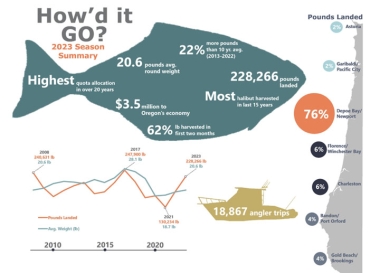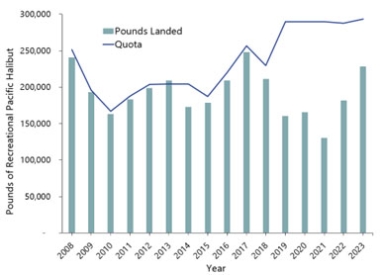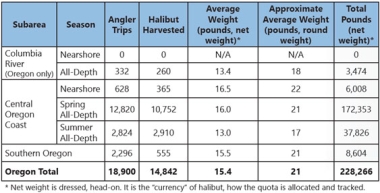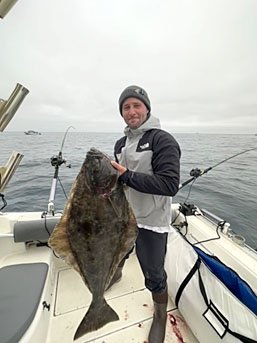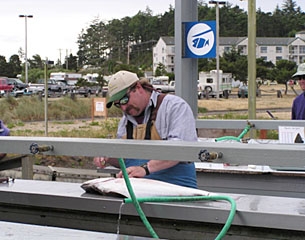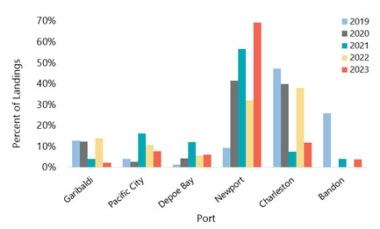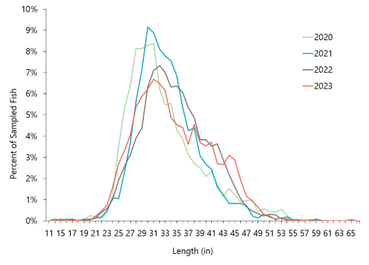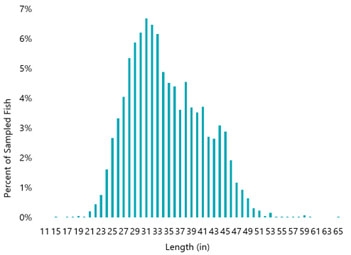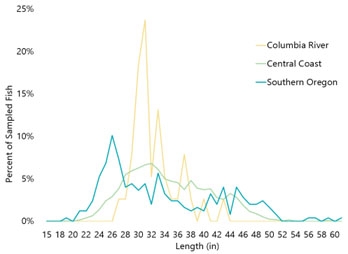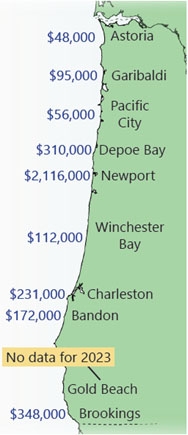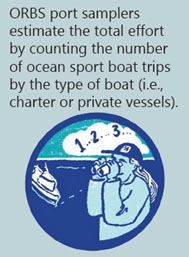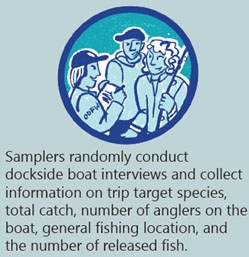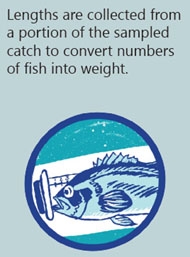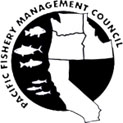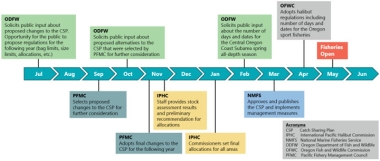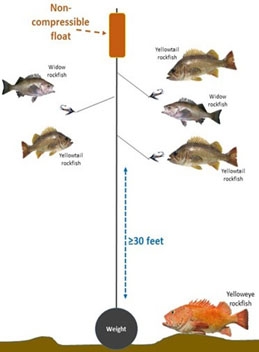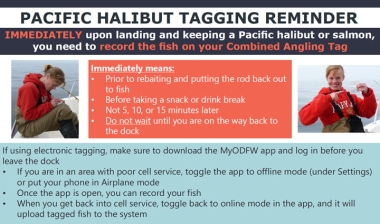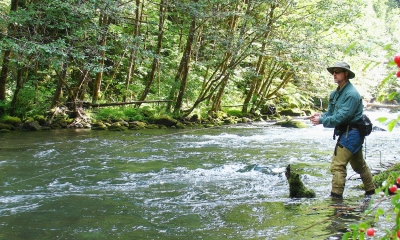
2023 Sport Halibut Newsletter
This newsletter provides a summary of Oregon’s 2023 sport halibut fishery.

Table of contents
- 2023 season summary
- Oregon subareas and allocations
- Enforcement
- Length frequency
- Economic impact
- Sport halibut monitoring update
- Regulating Pacific Halibut
- Other updates and reminders
2023 season summary
High landings, small but growing fish
The 2023 recreational Pacific halibut season brought along the highest allocation in over 20 years, and the landed halibut was just under 78 percent of this 293,436-pound quota. May was a productive start to the season with roughly 55,136 pounds landed (24 percent of the total landed). The highest landings were in June, however, with 86,582 pounds landed (38 percent of the total). There were 14,842 halibut landed this year, the most since 2008.
Newport had the highest halibut landings of any Oregon port in 2023, with 68.3 percent of the total weight (155,818 pounds). Depoe Bay landed just under 8 percent of the total weight (17,339 pounds). All other ports had landings under 15,000 pounds.
The average weight of all sport halibut landings in 2023 was 20.6 pounds round weight. This was slightly higher than the 2022 average round weight of 19.8 pounds, the 2021 average of 18.7 pounds, and the 2020 average of 18.4 pounds. This indicates that the average size of halibut is increasing, which could mean that anglers may see larger fish in their catch in the next couple of years. As anglers catch larger fish, landings are likely to be closer to the established quota. See length frequency section for more information.
Total landings increased in 2023, with 228,266 pounds landed in Oregon (Figure 1), 22 percent more than the ten-year average (2013-2022). There were 18,900 halibut angler trips this year, almost 2,000 more than in 2022.
The 2023 recreational Pacific halibut season generated approximately $3.5 million to Oregon's economy. See economic impact section for more information.
Oregon subareas and allocations
Fisheries for Pacific halibut in Oregon, Washington, and California are managed as Halibut Management Area 2A. This area accounts for about four percent of the volume of Pacific halibut in their entire range. These fish range from northern California through British Columbia and Alaska to Russia.
Oregon’s recreational fisheries get 29.7 percent of Management Area 2A’s non-tribal allocation. In 2021, this was 289,575 pounds of halibut.
In Oregon, this fishery is managed in three subareas:
- Columbia River
- Central Oregon Coast
- Southern Coast
Each subarea gets a certain amount of quota as shown on the map in Figure 2. In two of the subareas, the quota is divided based on depth and season (see table 1 below).
Columbia River Subarea
The Columbia River subarea is jointly managed by the Oregon and Washington Departments of Fish and Wildlife. This subarea's quota is split between the nearshore and all-depth fisheries.
Nearshore
The nearshore fishery was allocated 500 pounds of the quota. This lets anglers fishing for other species keep incidentally caught halibut when the all-depth halibut fishery is not open. As in the previous five years, there were no landings into Oregon ports and less than 50 pounds into Washington ports. The most landed in this fishery in any year is about 250 pounds. If effort and landings increase, the quota can be adjusted through the annual Catch Sharing Plan process, discussed in the regulating Pacific halibut section.
All-Depth
This fishery initially received 18,375 pounds of quota. The fishery was open every Thursday and Sunday from May 4-25 and Thursday and Sunday from June 1-30, as well as June 13 and June 20. Fishing started off fairly steady and remained open for all scheduled dates to the end of June, at which point just under 16,000 pounds had been landed.
Enough of the quota remained in the Columbia River and other subareas to re-open this fishery for a few extra days in August and September. During those extra days 3,374 pounds were landed. In total, the all-depth fishery landed 19,212 pounds, just over 800 pounds more than the subarea's initial quota. The overage was covered by quotas not used in other Oregon and Washington subareas.
Central Oregon Coast Subarea
This subarea's quota is split between the spring all-depth, nearshore, and summer all-depth fisheries.
Spring All-Depth
This fishery was open May 1 through June 30, seven days per week, with an initial quota of 173,385 pounds. Anglers fishing for halibut during all-depth halibut days were allowed to combine traditional bottomfish fishing (at any depth), including lingcod, or longleader gear fishing, excluding lingcod, with halibut. With the high price of gas, many anglers took advantage of the opportunity to combine halibut on all-depth halibut days with either the longleader or traditional bottomfish option.
The longleader fishery is a very specific gear-type fishery targeting prolific mid-water rockfish species offshore. For more information on the longleader gear fishery, see the longleader gear fishing section or visit myodfw.com/sport-bottomfish-seasons.
Beginning June 13, the daily bag limit for halibut increased to two halibut per angler, further increasing opportunity for anglers to harvest halibut. With remaining quota available, the fishery was also open July 10-16 and July 24-30.
Total landings were 172,353 pounds, a little over 25 percent more than what was landed in 2022. The average weekly landings were approximately 15,700 pounds.
Nearshore
This fishery was available to anglers for just under three weeks in 2023, during July and early August. The nearshore halibut fishery exists as part of the all-depth halibut fishery when halibut fishing is open at all-depths. There was decent fishing in early July as weather and ocean conditions allowed.
Due to the amount of quota remaining in the nearshore and all-depth seasons, the subarea was opened to all-depths daily beginning August 3. All landings after that date counted against the summer all-depth quota rather than the nearshore quota.
Historically, most of the landings from the nearshore fishery occur in Newport with Charleston a close second. However, in 2023, Newport had about 69 percent of the landings, and Charleston had a mere 12 percent. All other ports had less than 10 percent of the total landings (Figure 3).
Summer All-Depth
This fishery was open seven days per week beginning August 3 with an initial quota of 68,803 pounds. Effort and catches were steady throughout August but then dropped off. Even though the weather was very good through mid- October, coho salmon and albacore tuna opportunities most likely drew many anglers away from all-depth halibut. Halibut fishing closed by regulation on October 31 with 37,826 pounds landed.
Southern Oregon Subarea
This fishery opened May 1, seven days per week, with a quota of 8,000 pounds. Landings averaged around 260 pounds per week through June. In early July, with limited salmon opportunities in this area, halibut effort and landings increased, averaging about 500 pounds per week through Labor Day weekend.
The quota was reached in late September. However due to remaining quota in other Oregon areas, the Southern Oregon subarea remained open through the regulatory closure date of October 31. Total landings were 8,604 pounds, a slight decrease from last year's landings.
Enforcement
Three agencies patrol on land and at sea to enforce marine fishing regulations: the Marine Fisheries Team from the Oregon State Police Fish and Wildlife Division, the U.S. Coast Guard, and the NOAA Fisheries Office of Law Enforcement. Rules keep fisheries sustainable, and enforcement is a key piece of the overall fisheries management.
Common issues seen are:
- fishing without a license
- not immediately tagging landed halibut
- exceeding the bag limit
- keeping prohibited species, such as yelloweye or quillback rockfishes
- fishing in closed areas, such as Marine Reserves or the Stonewall Bank Yelloweye Rockfish Conservation Area
Length Frequency
In 2020, anglers and biologists throughout Oregon, California, Washington, and Alaska reported encountering many "small" 26-30 inch Pacific halibut. In 2021, anglers reported a lot of slightly larger 28-32 inch fish. And in 2022, anglers reported a lot of 30–35 inch fish. This year, more fish in the 30-38 inch range were caught. This trend tracks with growth of a large year class growing into the fishery.
The International Pacific Halibut Commission's (IPHC) annual survey shows the 2012 year-class is the largest since 2005. Halibut hatched in 2012 would be in the average size range of landed fish in 2020 through 2023, as shown in Figure 4.
2023 Lengths
Oregon Recreational Boat Survey (ORBS) samplers collected length information on 3,844 Pacific halibut in 2023. The figures on the left show the length frequency distribution of randomly sampled Pacific halibut during the 2023 recreational season.
|
|
|
Economic Impact
The recreational Pacific halibut fishery contributed approximately $3.5 million to Oregon's economy in 2023 through fishing-related costs such as gas, bait, gear, moorage, food, and hotels. This translates to about 38 full-time jobs.
Anglers fishing out of Newport contributed about $2.12 million (Figure 7). Anglers fishing out of Depoe Bay, Charleston, and Brookings added between $231,000 and $348,000 in each port. Even in ports with less halibut effort, halibut fishing can have an important role in local economies, especially in the spring and early summer before other fisheries, like salmon, begin.
Sport Halibut Monitoring Update
How Does MRP Monitor the Sport Pacific Halibut Fishery?
ODFW's Marine Resources Program (MRP) has a fishery monitoring program to collect critical recreational Pacific halibut fishery information to inform management recommendations. Sampling is conducted by ODFW's Ocean Recreational Boat Survey (ORBS). MRP thanks all our samplers and the industry for remaining flexible and maintaining safety when collecting samples this past year.
More information on ORBS and the Oregon recreational Pacific halibut fishery
Regulating Pacific Halibut
International Pacific Halibut Commission
The International Pacific Halibut Commission (IPHC) oversees all things Pacific halibut in the Eastern North Pacific Ocean. This includes Alaska, British Columbia, Washington, Oregon, and California.
IPHC conducts research and stock assessments and sets halibut harvest levels (allocations/quotas) for these areas including Regulatory Area 2A, which is Washington, Oregon, and California.
IPHC set Regulatory Area 2A's harvest level at 1.5 million pounds in 2019 through 2023, unless a conservation concern arose.
IPHC will set the quota for 2024, and possibly for several additional years, at its January 2024 annual meeting.
Pacific Fishery Management Council
The Pacific Fishery Management Council (PFMC) divides Regulatory Area 2A's quota (set by the IPHC) between Tribal, commercial, and recreational halibut fisheries. This information is outlined in the 2023 Pacific Halibut Catch Sharing Plan.
PFMC considers changes to the Catch Sharing Plan annually at its September and November meetings. Anglers can propose changes through that process.
ODFW holds public meetings each year in late July or early August to get angler input on how the fishery has gone so far that year and to discuss any proposed changes for the following year. These meetings tend to have lively discussions with participation from charter captains, individual anglers, fishing-related businesses, and sometimes even port officials. This public input helps form the recommendations for the following year's halibut fishery.
How & when to get involved
With several agencies involved in managing Pacific halibut, knowing how, when, and where to provide input or suggest changes can be confusing. PFMC, IPHC, and Oregon Fish and Wildlife Commission (OFWC) meetings are open to the public and provide time and opportunity for public comments (see Figure 8 below). More information can be found on each agency's website:
IPHC: iphc.int/
PFMC: www.pcouncil.org/
OFWC: www.dfw.state.or.us/agency/commission/
Other updates and reminders
Longleader Gear Fishing with All-Depth Halibut
In 2023, anglers could once again combine longleader gear fishing OR traditional bottomfish fishing with all-depth halibut fishing.
This year all-depth halibut anglers could also keep sablefish, Pacific cod, and flatfish species when combining longleader gear fishing. Anglers cannot retain lingcod while fishing with longleader gear.
As a reminder, longleader fishing and traditional bottomfish fishing cannot be combined on the same trip.
It is mandatory to have a descending device onboard the vessel when fishing for Pacific halibut or bottomfish and to use the device when releasing rockfish outside of the 30-fathom regulatory line.
More information on the longleader gear fishery
More info on tagging Pacific halibut
For current information about Pacific halibut & inseason changes please visit: myodfw.com/pacific-halibut-sport-regulations
We are always interested in hearing from you about your fishery and the issues that are important to you.
Oregon Department of Fish and Wildlife,
Marine Resources Program
2040 SE Marine Science Dr., Newport, OR 97365
541-867-4741
Christian Heath
Halibut & Recreational Groundfish Project Leader
Christian.T.Heath@odfw.oregon.gov
Melanie Bukovec
Groundfish & Halibut Assistant Project Leader
Melanie.A.Bukovec@odfw.oregon.gov

